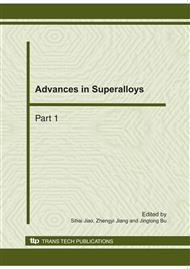p.1769
p.1775
p.1780
p.1784
p.1788
p.1792
p.1797
p.1801
p.1806
Cooling by the Sine Function to Produced Semi-Solid Aluminum Alloys
Abstract:
There are many advantages of semi-solid processing technology such as energy saving, high efficiency and net-shaped processing. So it is a promising manufacturing technology in 21 century .It is the premise of getting the non-dendrite semisolid slurry to realize the semisolid processing.This paper reviewed the development of the technique of preparation for semi-solid state slurry and introduced some new researchment about the technique of preparation slurry for semi-solid processing. It researched a new technique of preparation for semi-solid state slurry—cooling by the sine function to produced the semi-solid state slurry. The result showed that the aluminum alloy melt was cooled and controlled nucleation and limited growth in the sine wave The fundamental principles through which sound semi-solid slurry can be effectively obtained were summarized.On the basis of the experiment and simulation,it analysised the temperature field and the flow field of the semisolid 2A12 slurry flow through sine passage. The result showed that there is the cooling and the self-stirring when the semisolid 2A12 slurry flow through sine passage. The fundamental principles through which sound semi-solid slurry can be effectively obtained were summarized. Finally, we presented a patent this simple process .
Info:
Periodical:
Pages:
1788-1791
Citation:
Online since:
October 2010
Authors:
Keywords:
Price:
Сopyright:
© 2011 Trans Tech Publications Ltd. All Rights Reserved
Share:
Citation:


